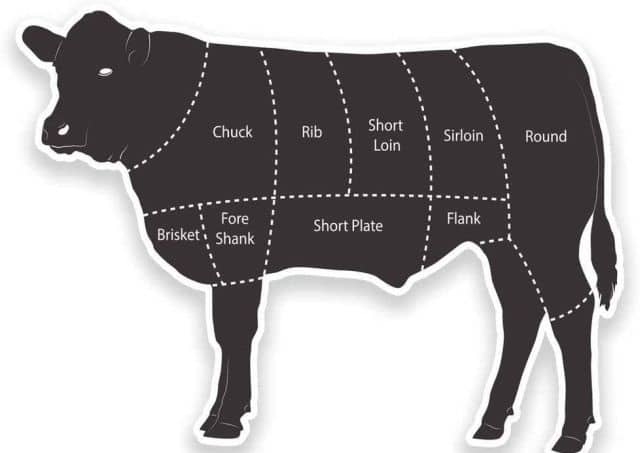Everyone knows hamburgers are pretty near the top of the tailgater’s food chain. They consistently hold the top spot survey after survey. When it comes to eating, Americans love beef. We consumed 28.7 billion pounds of beef in 2024and the USDA states that 46% of that was ground. Most people already know where to get their favorite hamburger but buying fresh beef can be confusing without knowing a bit about the various options, grades, cuts and cooking methods.
Beef is graded by the USDA based on the amount of marbling (fat within the lean), firmness and texture, and the color of the beef. The most common grades you’ll find are:
- Prime – beef with the most marbling, usually sold to restaurants and specialty meat markets but now also available in some grocery stores as well as Sam’s Club and Costco.
- Choice – the most widely available grade on the market with a little less marbling than prime.
- Select – the grade with the least amount of marbling, this grade is leaner but can also be less juicy and less flavorful.
Beyond the grade of the beef one thing to take into consideration is how and where the beef is raised. Most of the beef available to consumers comes from conventionally raised cattle. These are cows that have been raised on pasture for six months and then shipped to feedlots for “finishing” where they are fed a high calorie diet to fatten them up and gain intramuscular fat, which is what marbling is. Most of the feed consists of processed corn and other grains. Some of these cows also receive growth hormones and antibiotics to prevent illness.
Beef that is marked “Certified Organic” must be raised under USDA standards that require cattle be fed 100% organic feed and have access to pasture. They may be grain-finished but they cannot be given growth hormones or antibiotics. Grass-finished beef is marked by the USDA as certified “Grass-Fed” and must be fed on a 100% pasture diet their entire life. Most grass-finished beef is available in late spring and early summer due to the seasonality of the pasture.
Finally, in addition to any of the social or environmental benefits derived from buying beef free of growth hormones and antibiotics, there is the fact that beef produced in this manner typically has more flavor. Check with your local butcher shop to see if they can get beef from a quality source where they know all the details from the ranch to the feed yard to the slaughterhouse.
Knowing where the meat comes from is important. The breed of cattle obviously makes a difference but so does the region in which they are raised and how they are handled. Since all cattle eat grass, variations in soil and climate as well as the grass or grains itself will affect the taste and texture of the meat.
As with wine, the aging process also plays a huge part in the flavor of beef. A primary purpose of aging beef is to help tenderize it. Dry-aged beef is more expensive because the meat is kept at 34-36 degrees Fahrenheit, exposed to the air, for as long as 8 weeks and it can lose as much as 20 percent of its weight due to evaporation and trimming.
By contrast, wet-aging means the meat has been kept in plastic wrap [you might use vacuum sealed plastic instead] for a period of time, sometimes for just a few days. With wet-aging, since the meat is not exposed to the air it doesn’t lose weight to evaporation or trimming. While wet-aging can also influence flavor, one does not see typically see the same concentration of flavors as with dry-aged beef.
Once you’ve found a good source for your beef the next thing to determine is which cuts to buy and how to prepare them. There are eight primal cuts in a cow consisting of the Chuck/Shoulder, Rib, Short Loin, Sirloin, Round, Brisket/Shank, Plate, and Flank.

The first five cuts in that list follow along the top of the cow and the last three cuts run along the top of the legs and under the cow. The rib and short loin sections are where the most tender and most expensive cuts come from including rib eye steaks, prime rib, and rib roast from the rib section and New York strip steak, T-bone steak, porterhouse and filet mignon from the short loin.
Cuts from the sirloin section are also very tender but tend to be better with a marinade. Tri tip comes from this section and is common on the west coast. In other parts of the country, it gets cut up into sirloin tips. The tougher cuts come from the more exercised parts of the animal like the shoulder and the rump.
These require moist heat cooking to melt the collagen in the connective tissue and become tender. Braising, slow cooking, and smoking can turn cuts like the 7-bone roast (named for its numerical shaped bone) or the brisket into a delicious meal. Pot roast is most frequently made by browning a chuck roast and then slow cooking in liquid.
If you aren’t familiar with the Plate section of the cow, that’s where skirt steak and hanger steak come from. As with flank steaks these are best if marinated overnight and then cooked quickly to medium rare. Anything beyond medium will be extremely tough to chew. It is also always recommended on tougher cuts of meat like the flank steak or tri-tip to slice the meat against the grain to cut the long muscle fibers for easier chewing.
With all of cuts of beef available there’s a lot more to it than double cheeseburgers and there are countless recipes available online. Don’t be afraid to try something new and to step out of the box to get beef somewhere other than the supermarket. You might find something you really enjoy.


